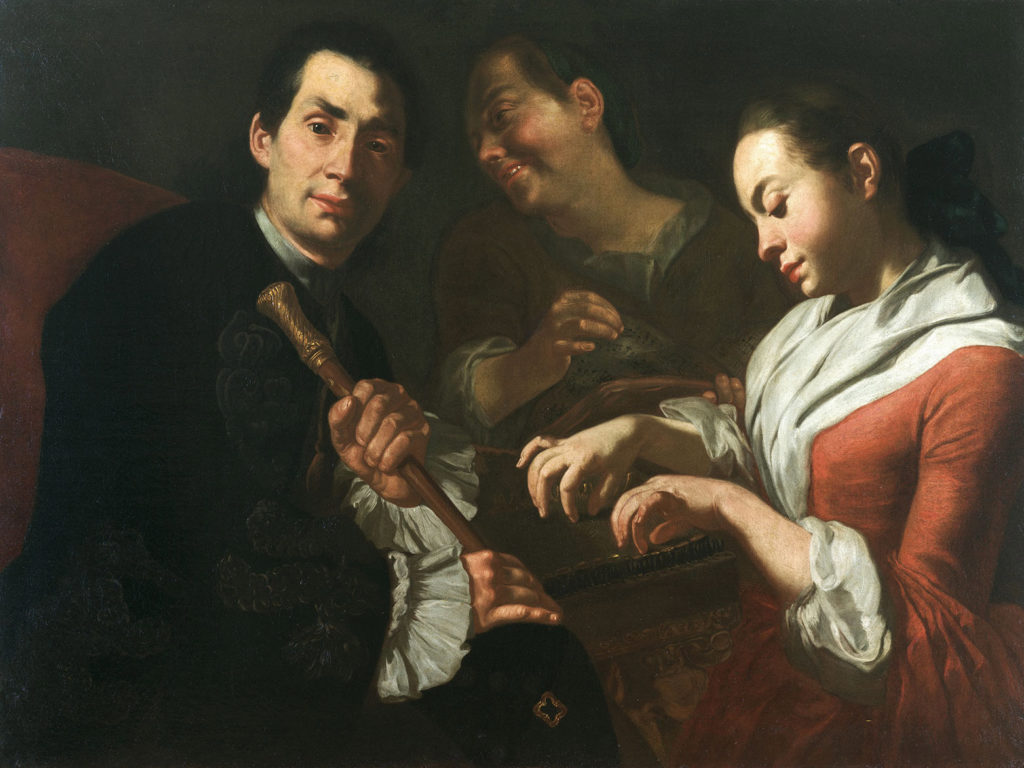
Olio su tela, cm 76 x 102
Gaspare Traversi (Napoli 1722 – Roma 1770)
“Troppo disgradevole agli occhi dei viventi.”
“Solo artista veramente ineliminabile del suo tempo.”
In queste due affermazioni, la prima dei frati di S. Francesco a Nazzano e la seconda di Ferdinando Bologna, è racchiusa la fortuna critica di Gaspare Traversi, riemerso dalla nebbia del tempo grazie ad un intuizione di Roberto Longhi, a cui fecero seguito attenti studi che andarono a creare non pochi attriti con altri storici del secolo scorso.
Alla fine, l’artista viene ben inquadrato nei suoi dipinti di un realismo civile, come sardonico censore dei vizi e delle imposture della società, ed infine celebrato nella la mostra monografica del 2003 curata da Nicola Spinosa.
A questo scopo, Traversi si rifà spesso a l’opera buffa napoletana riproducendo delle scene ben individuabili nel contesto di taluni libretti.
Questo forte elemento di teatralità ha fatto accostare e non di rado sovrapporre la sua personalità artistica a tutta una serie di pittori che hanno variamente rappresentato con una certa ironia e criticità il mondo e la società che li circondavano.
Tra essi, il nome che più spesso ricorre è quello di Hogarth, ma va notato che”Mentre la critica di Hogarth serve come morale e come insegnamento, il Traversi deride e con ciò ‘umilia’ la vita borghese non offrendo in cambio nessun valore positivo” (Michael Liebmann).
Sarebbe forse il caso di parlare di interdisciplinarità tra pittura, musica e commedia e approfondire il rapporto certamente esistente tra il Traversi, artista rifiutato da una societa che non ha orrore di se e che non ama vedersi derisa , e Pietro Trinchera, librettista che componeva solo in lingua napoletana, tenuto costantemente sotto sorveglianza dalla censura, finito anche in carcere per il contenuto ‘sovversivo’ dei suoi scritti ed infine suicidatosi per debiti.
Questo dipinto ben racconta una di quelle situazioni ambigue spesso rappresentate nei teatri napoletani ma molto più spesso vissute nei salotti della città: vediamo in esso un tipico rappresentante di una nobiltà ignorante e apatica, poco interessato alla musica, che guarda verso lo spettatore in modo complice e ammiccante; la suonatrice finge concentrazione mentre suona un salterio ma già accenna un sorriso malizioso e la terza figura, la mezzana, ride apertamente contenta della già prevista e programmata conclusione.
English version
“Too much revolting in the eyes of the living”
“Only truly unavoidable artist of his time.”
These two statements, the first written by the friar S. Francesco a Nazzano and the second by friar Ferdinando Bologna, include the critique of Gaspare Traversi, who came to light thanks to the insight of Roberto Longhi, whose detailed studies caused many frictions among the other historians of the last century.
In the end, in his drawings full of civil realism, the artist is placed as a sardonic censor of vices and deception of society and he is celebrated in the monographic exhibition of 2003 curated by Nicola Spinosa
At this stage Traversi takes often inspiration from the neapolitan low comedy reproducing scenes well detectable in the context of some Libretto.
This strong element of theatricality compared and overlapped his artistic personality to a number of painters who have represented the society surrounding them with irony and criticality.
Among them Hogarth is the one recurring frequently but: while Hogarth’s critique is moral and serves as a lesson, Traversi’s one derides and humiliates the middle class life without giving any positive value.
(Michael Liebmann).
Would be the time to speak of the interdisciplinarity among painting, music and comedy and analyse the existing relationship between Traversi, refused by a no more terrified society which doesn’t want to be mocked anymore and Pietro Trinchera, librettist who composed in Neapolitan. He was constantly placed under censorship supervision, went to prison because of the seditious subjects of his printed texts and then committed suicide due to his debts.
This painting tells about one of the most ambiguous situations represented in Neapolitan theatres but often lived in parlors too: the typical proponent of an ignorant and apathetic aristocracy not interested in music, who looks at the audience in a complicit way. The musician pretends to be concentrated while is playing the psaltery but she already hints at a mischievous smile and the third figure, the procurer, laughs hardly due to the expected and planned conclusion.